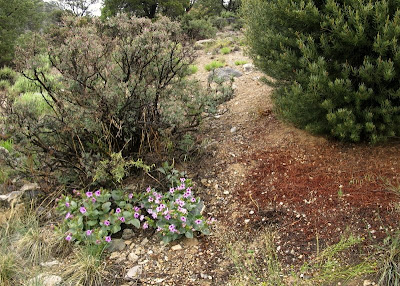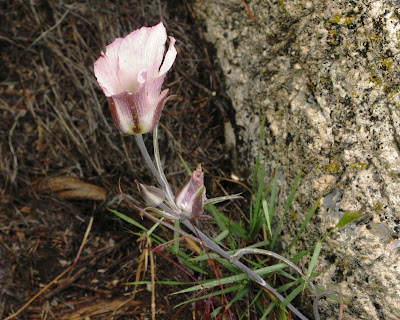 The last time we went hiking up our hiking hill, it was the day before Father's Day, and one of our heaviest rainstorms of the barely pre-summer season was in progress. The sky poured and drizzled water on us while we hiked. The ground was soft, not quite muddy. As per usual, I took a few photos, even though photography was hampered some by the rain and dripping trees.
The last time we went hiking up our hiking hill, it was the day before Father's Day, and one of our heaviest rainstorms of the barely pre-summer season was in progress. The sky poured and drizzled water on us while we hiked. The ground was soft, not quite muddy. As per usual, I took a few photos, even though photography was hampered some by the rain and dripping trees. Yes, we have trees in the part of the intermountain west commonly known as the Great Basin, which is also part of the larger Basin and Range. The tree above is a piñon pine tree, an old one. Many of the old ones on the trail up to Squaw Peak were burned by some long-ago brushfire. Their bark is black, their shapes are twisted, their needles are plentiful.
Yes, we have trees in the part of the intermountain west commonly known as the Great Basin, which is also part of the larger Basin and Range. The tree above is a piñon pine tree, an old one. Many of the old ones on the trail up to Squaw Peak were burned by some long-ago brushfire. Their bark is black, their shapes are twisted, their needles are plentiful. The sky was everywhere gray, misty, and obscure. Raindrops glistened and sparkled, suspended from fire-black and rain-darkened branches. Each raindrop contained a small green world.
The sky was everywhere gray, misty, and obscure. Raindrops glistened and sparkled, suspended from fire-black and rain-darkened branches. Each raindrop contained a small green world. The rain intensified colors. The greens of sagebrush, rabbitbrush, piñon, juniper, and bitterbrush became greener. The umbers and ochres of fallen needles became deeper. Flowers almost glowed.
The rain intensified colors. The greens of sagebrush, rabbitbrush, piñon, juniper, and bitterbrush became greener. The umbers and ochres of fallen needles became deeper. Flowers almost glowed. I'm not sure what this flowering plant is, also seen in the previous photo, possibly it's Mirabilis multiflora. I don't recall seeing it last year, but I might have missed it. It was usually smaller than this particular example, and was often hiding at the base of bushes or beneath trees on south- and west-facing slopes, from about 6760 feet to at least 7320 feet.
I'm not sure what this flowering plant is, also seen in the previous photo, possibly it's Mirabilis multiflora. I don't recall seeing it last year, but I might have missed it. It was usually smaller than this particular example, and was often hiding at the base of bushes or beneath trees on south- and west-facing slopes, from about 6760 feet to at least 7320 feet.
 I was lucky to spot these small, delicate tulip-like flowers; I have been unable to identify them. They were growing in a broadly flat area at about 6700 feet. UPDATE: These plants appear to be some variety of Calochortus, some varieties of which are called mariposa lily.
I was lucky to spot these small, delicate tulip-like flowers; I have been unable to identify them. They were growing in a broadly flat area at about 6700 feet. UPDATE: These plants appear to be some variety of Calochortus, some varieties of which are called mariposa lily.
 Prickly pear, Opuntia, was wonderfully in bloom at the lower elevations of 6700 to 6900 feet. The flowers were pale orange to yellow with rose-like petals. Red or magenta prickly pear had already bloomed earlier in the year and higher on the mountain.
Prickly pear, Opuntia, was wonderfully in bloom at the lower elevations of 6700 to 6900 feet. The flowers were pale orange to yellow with rose-like petals. Red or magenta prickly pear had already bloomed earlier in the year and higher on the mountain. Sagebrush, sea-green with wet, dark-brown woody branches, grows in clumps around a larger plant that has already bloomed and is going to seed.
Sagebrush, sea-green with wet, dark-brown woody branches, grows in clumps around a larger plant that has already bloomed and is going to seed. The tall seedy plant is probably Atriplex canescens, commonly known as fourwing saltbush. I was surprised to it growing at such a high elevation, at the low end of the piñon-juniper zone (6700 feet). There were only a few Atriplex bushes. They were two to four feet in height, and had few leaves. I first suspected Grayia (hopsage), which is usually a low-elevation plant, also, but the leaves weren't right.
The tall seedy plant is probably Atriplex canescens, commonly known as fourwing saltbush. I was surprised to it growing at such a high elevation, at the low end of the piñon-juniper zone (6700 feet). There were only a few Atriplex bushes. They were two to four feet in height, and had few leaves. I first suspected Grayia (hopsage), which is usually a low-elevation plant, also, but the leaves weren't right. Another unknown: this stalk is more than three feet tall, most were one to two feet in height.
Another unknown: this stalk is more than three feet tall, most were one to two feet in height.
 Beautiful small white to pink flowers were growing in clumps at about 6600 feet.
Beautiful small white to pink flowers were growing in clumps at about 6600 feet. We got wet, even with rain-protective clothing. We got cold coming back down from 7400 feet, even though we were fairly well bundled. It was a beautiful day.
We got wet, even with rain-protective clothing. We got cold coming back down from 7400 feet, even though we were fairly well bundled. It was a beautiful day.This post is a submission to the Carnival of the Arid #5, which is hosted at Coyote Crossing by Chris Clarke.
5 comments:
That is so true! Normally, I hate being in the rain, but those nice photos of yours showed me that it's worth getting in the rain sometimes to see the beauties of nature especially on a hike. Now, I won't be so tempted to sleep when it rains, lol. And, I won't grumble if it rains like that. Truly Excellent!!
Try looking up mariposa or butterfly lilies for the first flowers you couldn't identify. Those look like they might be your local variety (there are many different species).
Raptor Lewis, it's nicer if it's a warm rain, but even the colder rains can be nice.
Coconino, I think you're right, it looks a lot like some kind of Calochortus - there are several possibilities. I'll see if they have opened up more next time I go up there.
Nice colors on those prickly pear blooms. I like hiking in the desert in the rain too. All the colors are intensified as you pointed out, I usually see more reptiles, and I love the smell of creosote in the rain.
We've been getting a lot of rain hiking this spring - and summer, now, also! I've almost forgotten the smell of creosote in the rain, was surprised during our May trip to the Mojave how the scent of creosote (dry) brought back memories. Our sagebrush looks like it might bloom early this year, but maybe it's just getting ready to bloom really, really heavy.
Post a Comment